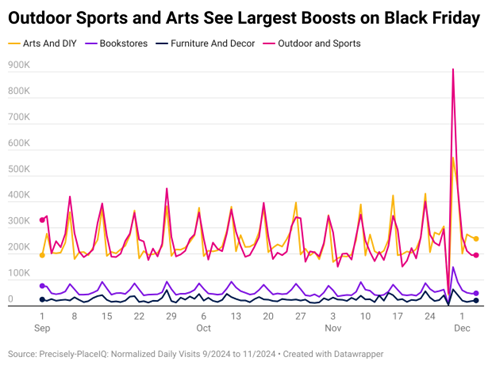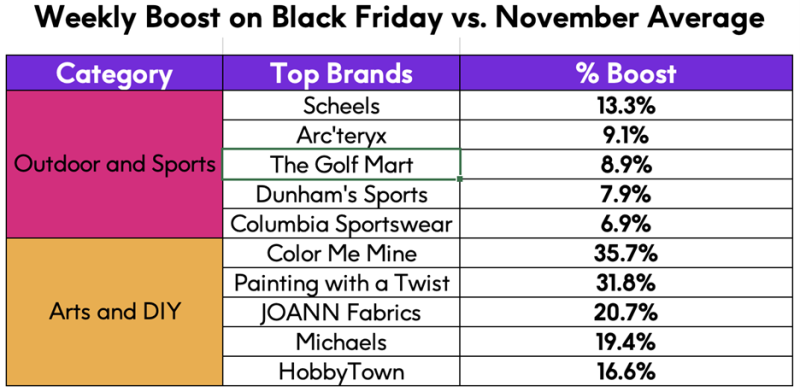
How Black Friday Foot Traffic Offers a Glimpse into Retail’s Future

Black Friday has long represented a high-stakes opportunity for retailers, with Big Box and electronics giants vying for dominance. However, this year told a different story. Google Trends revealed an unexpected rise in interest in hobby stores, particularly outdoor retailers and arts-and-crafts shops. This shift signals more than a seasonal anomaly—it reflects a profound change in what customers value. Searches for “camping gear,” “art supplies,” and “DIY projects” highlight a cultural pivot toward purchases that foster creativity, connection, and transformation.
Customers now seek more than low prices and convenience. They demand experiences that enrich their lives, and retailers using visit intelligence and foot traffic analytics are already capitalizing on these trends to redefine retail’s future.
Connecting Online Patterns to Real-World Visit Data
Retailers that integrate digital behavior with physical-world insights gain a decisive edge in today’s evolving market. Foot traffic analytics transforms raw visit data into actionable strategies, helping businesses bridge the gap between online interest and in-store engagement. Tools like location intelligence provide even greater depth, revealing not only the volume of foot traffic but also the specific stores, regions, or experiences drawing customers.
For instance, a spike in Google searches for “camping gear” or “DIY furniture projects” may indicate growing interest in outdoor adventures or home improvement activities. However, visit data gives retailers the real-world evidence needed to act decisively. By analyzing how online trends translate into store visits, businesses can fine-tune their inventory, optimize promotional campaigns, and enhance in-store experiences to better serve their customers.
Black Friday Visit Boosts
This year’s Black Friday visitation data paints a vivid picture of these evolving trends. Outdoor retailers saw a remarkable 3x increase in visits compared to their three-month average, while arts-and-crafts stores recorded a 2x rise. These surges highlight a cultural shift as customers transition from passive consumption to engaging in activities that foster creativity and connection.

The boost in outdoor retailer visits reflects a growing desire for experiences like hiking, camping, and exploration, with customers investing in gear that facilitates these adventures. Meanwhile, arts-and-crafts stores benefit from an increased focus on hobbies that encourage personal expression, such as painting, DIY décor, and crafting projects.
Brands Thriving from Black Friday Visits
A closer look at the outdoor and arts-and-crafts retailers reveals they are positioning themselves as more than places to shop— these retailers become enablers of experiences that drive shoppers and foot traffic.

Outdoor Retailers: Selling Adventure, Not Gear
Scheels emerged as a standout performer in the outdoor category, achieving a 13.3% increase in store visits during Black Friday compared to its November average. Arc’teryx followed with a 9.1% boost, and The Golf Mart recorded an 8.9% rise. Customers aren’t visiting these stores solely for products—they’re seeking inspiration and opportunities to embrace adventure.
Scheels exemplifies this approach by positioning its stores as hubs for outdoor exploration. Rather than simply selling hiking boots or fishing rods, it offers expertise, tools, and events that help customers craft unforgettable experiences.
Arts-and-Crafts Retailers: Fueling Creativity
Arts-and-crafts stores saw similarly impressive results. Color Me Mine recorded a 35.7% increase in footfall, while Painting with a Twist and JOANN Fabrics gained 31.8% and 20.7%, respectively. These brands succeed because they offer more than materials—they create spaces for self-expression and connection.
Color Me Mine invites customers into a collaborative environment where they can create ceramics while spending quality time with others. JOANN Fabrics takes a blended approach, pairing in-store crafting classes with digital tutorials to engage customers wherever they are.
Redefining Retail’s Role
These shifts underscore a key reality: the role of retail is changing. Outdoor gear, crafting supplies, and hobby kits are no longer just products—they’re gateways to personal growth, creativity, and connection. A tent symbolizes adventure. A paint set transforms into a tool for self-expression. Retail is becoming a space for transformation. And by embracing location intelligence and footfall analytics, retailers can identify trends and optimize their offerings to align with customer needs.
Read Our Handbook
Precisely PlaceIQ Syndicated Audience Handbook
Read this handbook and explore real-world audiences to discover new and innovative ways to reach high-value consumers.
Action Steps for Retailers
To stay competitive in this evolving environment, retailers must move beyond transactions and offer experiences that resonate with customers. Here’s how:
1. Use Daily Visit Count to Refine Strategy
Visit data is crucial for understanding where customers go and why. Tools like the Daily Visitation Count help retailers analyze foot traffic patterns and identify opportunities. For instance, if garden centers in a region see increased visits, retailers can respond with tailored promotions or workshops focused on sustainable planting.
This data-driven approach allows businesses to optimize inventory, refine marketing campaigns, and create in-store experiences that align with customer preferences.
2. Create Immersive Experiences
Retailers must turn their spaces into destinations where customers can deeply engage. These experiences don’t just increase footfall; they foster emotional connections that drive loyalty and repeat visits.
Outdoor retailers, for example, can host gear-testing events or guided nature hikes, transforming shopping into an adventure. Hobby stores like JOANN Fabrics and Color Me Mine lead the way with workshops and community-focused activities, giving customers tangible reasons to return.
Beyond Black Friday: The Future of Retail
The implications of this trend go far beyond the holiday season. By leveraging visit intelligence and focusing on experiential retail, stores can build year-round engagement. Hobby stores have proven that the future lies in creating spaces where customers connect, learn, and grow. Success will come to those who build meaningful experiences and help customers unlock their potential.


